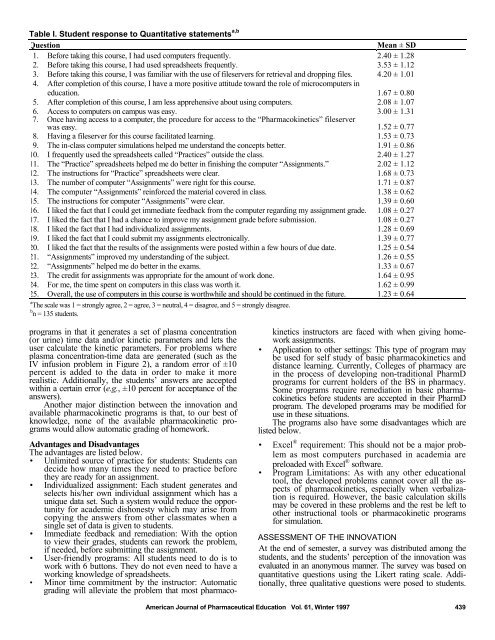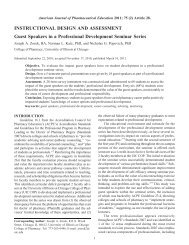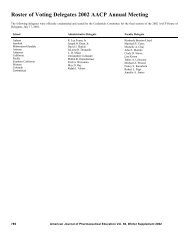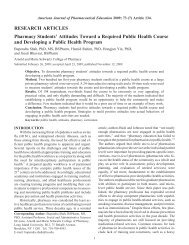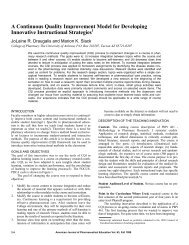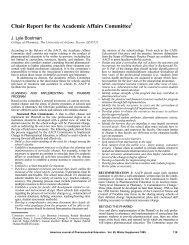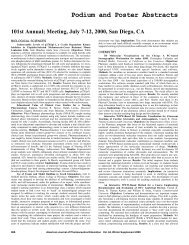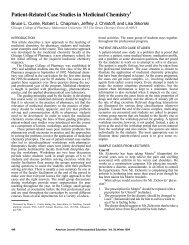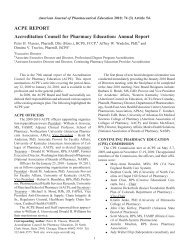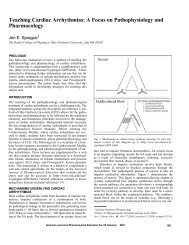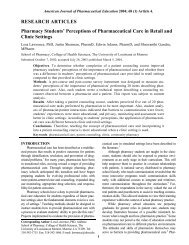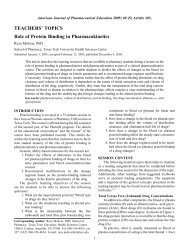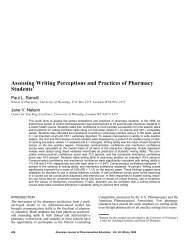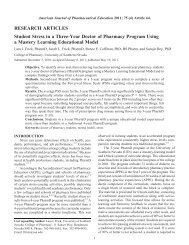View PDF - AJPE - The American Journal of Pharmaceutical Education
View PDF - AJPE - The American Journal of Pharmaceutical Education
View PDF - AJPE - The American Journal of Pharmaceutical Education
You also want an ePaper? Increase the reach of your titles
YUMPU automatically turns print PDFs into web optimized ePapers that Google loves.
Table I. Student response to Quantitative statements a,b<br />
Question<br />
Mean ± SD<br />
1. Before taking this course, I had used computers frequently. 2.40 ± 1.28<br />
2. Before taking this course, I had used spreadsheets frequently. 3.53 ± 1.12<br />
3. Before taking this course, I was familiar with the use <strong>of</strong> fileservers for retrieval and dropping files. 4.20 ± 1.01<br />
4. After completion <strong>of</strong> this course, I have a more positive attitude toward the role <strong>of</strong> microcomputers in<br />
education. 1.67 ± 0.80<br />
5. After completion <strong>of</strong> this course, I am less apprehensive about using computers. 2.08 ± 1.07<br />
6. Access to computers on campus was easy. 3.00 ± 1.31<br />
7. Once having access to a computer, the procedure for access to the “Pharmacokinetics” fileserver<br />
was easy. 1.52 ± 0.77<br />
8. Having a fileserver for this course facilitated learning. 1.53 ± 0.73<br />
9. <strong>The</strong> in-class computer simulations helped me understand the concepts better. 1.91 ± 0.86<br />
10. I frequently used the spreadsheets called “Practices” outside the class. 2.40 ± 1.27<br />
11. <strong>The</strong> “Practice” spreadsheets helped me do better in finishing the computer “Assignments.” 2.02 ± 1.12<br />
12. <strong>The</strong> instructions for “Practice” spreadsheets were clear. 1.68 ± 0.73<br />
13. <strong>The</strong> number <strong>of</strong> computer “Assignments” were right for this course. 1.71 ± 0.87<br />
14. <strong>The</strong> computer “Assignments” reinforced the material covered in class. 1.38 ± 0.62<br />
15. <strong>The</strong> instructions for computer “Assignments” were clear. 1.39 ± 0.60<br />
16. I liked the fact that I could get immediate feedback from the computer regarding my assignment grade. 1.08 ± 0.27<br />
17. I liked the fact that I had a chance to improve my assignment grade before submission. 1.08 ± 0.27<br />
18. I liked the fact that I had individualized assignments. 1.28 ± 0.69<br />
19. I liked the fact that I could submit my assignments electronically. 1.39 ± 0.77<br />
20. I liked the fact that the results <strong>of</strong> the assignments were posted within a few hours <strong>of</strong> due date. 1.25 ± 0.54<br />
21. “Assignments” improved my understanding <strong>of</strong> the subject. 1.26 ± 0.55<br />
22. “Assignments” helped me do better in the exams. 1.33 ± 0.67<br />
23. <strong>The</strong> credit for assignments was appropriate for the amount <strong>of</strong> work done. 1.64 ± 0.95<br />
24. For me, the time spent on computers in this class was worth it. 1.62 ± 0.99<br />
25. Overall, the use <strong>of</strong> computers in this course is worthwhile and should be continued in the future. 1.23 ± 0.64<br />
a <strong>The</strong> scale was 1 = strongly agree, 2 = agree, 3 = neutral, 4 = disagree, and 5 = strongly disagree.<br />
b n = 135 students.<br />
programs in that it generates a set <strong>of</strong> plasma concentration<br />
(or urine) time data and/or kinetic parameters and lets the<br />
user calculate the kinetic parameters. For problems where<br />
plasma concentration-time data are generated (such as the<br />
IV infusion problem in Figure 2), a random error <strong>of</strong> ±10<br />
percent is added to the data in order to make it more<br />
realistic. Additionally, the students’ answers are accepted<br />
within a certain error (e.g., ±10 percent for acceptance <strong>of</strong> the<br />
answers).<br />
Another major distinction between the innovation and<br />
available pharmacokinetic programs is that, to our best <strong>of</strong><br />
knowledge, none <strong>of</strong> the available pharmacokinetic programs<br />
would allow automatic grading <strong>of</strong> homework.<br />
Advantages and Disadvantages<br />
<strong>The</strong> advantages are listed below.<br />
• Unlimited source <strong>of</strong> practice for students: Students can<br />
decide how many times they need to practice before<br />
they are ready for an assignment.<br />
• Individualized assignment: Each student generates and<br />
selects his/her own individual assignment which has a<br />
unique data set. Such a system would reduce the opportunity<br />
for academic dishonesty which may arise from<br />
copying the answers from other classmates when a<br />
single set <strong>of</strong> data is given to students.<br />
• Immediate feedback and remediation: With the option<br />
to view their grades, students can rework the problem,<br />
if needed, before submitting the assignment.<br />
• User-friendly programs: All students need to do is to<br />
work with 6 buttons. <strong>The</strong>y do not even need to have a<br />
working knowledge <strong>of</strong> spreadsheets.<br />
• Minor time commitment by the instructor: Automatic<br />
grading will alleviate the problem that most pharmacokinetics<br />
instructors are faced with when giving homework<br />
assignments.<br />
• Application to other settings: This type <strong>of</strong> program may<br />
be used for self study <strong>of</strong> basic pharmacokinetics and<br />
distance learning. Currently, Colleges <strong>of</strong> pharmacy are<br />
in the process <strong>of</strong> developing non-traditional PharmD<br />
programs for current holders <strong>of</strong> the BS in pharmacy.<br />
Some programs require remediation in basic pharmacokinetics<br />
before students are accepted in their PharmD<br />
program. <strong>The</strong> developed programs may be modified for<br />
use in these situations.<br />
<strong>The</strong> programs also have some disadvantages which are<br />
listed below.<br />
• Excel ® requirement: This should not be a major problem<br />
as most computers purchased in academia are<br />
preloaded with Excel ® s<strong>of</strong>tware.<br />
• Program Limitations: As with any other educational<br />
tool, the developed problems cannot cover all the aspects<br />
<strong>of</strong> pharmacokinetics, especially when verbalization<br />
is required. However, the basic calculation skills<br />
may be covered in these problems and the rest be left to<br />
other instructional tools or pharmacokinetic programs<br />
for simulation.<br />
ASSESSMENT OF THE INNOVATION<br />
At the end <strong>of</strong> semester, a survey was distributed among the<br />
students, and the students’ perception <strong>of</strong> the innovation was<br />
evaluated in an anonymous manner. <strong>The</strong> survey was based on<br />
quantitative questions using the Likert rating scale. Additionally,<br />
three qualitative questions were posed to students.<br />
<strong>American</strong> <strong>Journal</strong> <strong>of</strong> <strong>Pharmaceutical</strong> <strong>Education</strong> Vol. 61, Winter 1997 439


